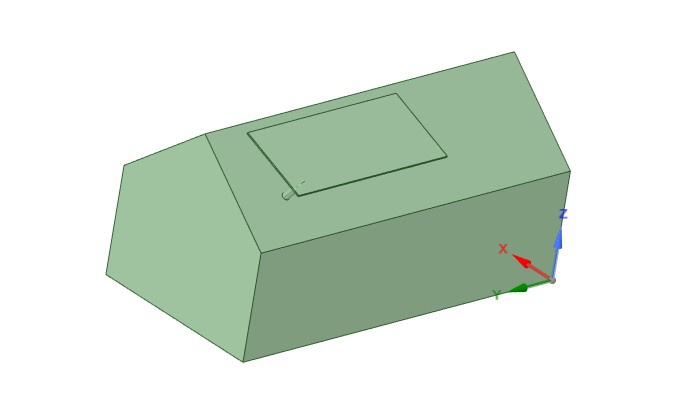-
-
November 8, 2020 at 3:30 pm
Ansysstudent5361
SubscriberHi,
I'm looking at wind loading on rooftop located solar panel. I wanted to ask if my geometry was correct for the modelling. This looks like what I want but functionally is there anything I should do? Should I separate the solar panel and building as two solids? What are some best practices for geometry creation so I can mesh this easily and get accurate results? I have not created my fluid domain yet but its just an enclosure with domain dimensions taken from literature. I'm asking this because my previous model was a real pain to mesh and did not mesh properly so I started from scratch again. Can someone guide me on meshing this?
November 9, 2020 at 6:41 amKeyur Kanade
Ansys EmployeeIf I understand you question correctly, then please use single solid. nRemove that small thickness of solar panel. Make it planar with roof. nThen create fluid volume. nThen use 'Groups' in SpaceClaim. Create a group for the face of solar panel. This will come in as Named Selection in Meshing. nOnce you create fluid volume, please go ahead with tet + inflation meshing. nnRegards,nKeyurnGuidelines for Posting on Ansys Learning ForumnHow to access ANSYS help linksNovember 9, 2020 at 11:48 amAnsysstudent5361
SubscriberHi, nThank you for replying. What if i wanted a different orientation of the panel with respect to the inclination of my roof? My model currently is a single solid but I want to keep the panel elevated from the roof at a slightly different angle as to that of the roof. Thanks.nNovember 9, 2020 at 12:08 pmRob
Forum ModeratorI would make a solid for the building (and then subtract from the domain) and a solid for the panel and region between it and the roof. The surface where the top of the panel is will be a wall, the volume between it & the roof will be fluid. No need to give the panel a CAD thickness unless you really want to add that much mesh to the domain. nNovember 9, 2020 at 2:01 pmAnsysstudent5361
SubscriberHi,nJust to clarify, I can create a base building model (solid) and subtract it from the domain. Then, i could create a volume on top of my base building , create a named selection on the surface of the volume (to create panel) and when i send it to mesh and fluent, I basically tell fluent to keep the surface as wall? If that is the case, I will try this way. Thank you. My question is when fluent asks us to define cell boundary, won't this be considered as fluid? Can we set the surface only as some other material? Or is simply specifying as wall enough for my model.....I apologize if my questions are ignorant, I'm new to this but I'm also excited in learning Ansys.nNovember 10, 2020 at 12:31 pmRob
Forum ModeratorYes, the term you're looking for is a Named Selection to give the panel a name. You'll finish up with a wall and wall:shadow pair in Fluent to represent the two sides of the wall. The cells are fluid (so air passes under the panel) but the wall (panel) will block flow. nYour questions show you're learning. I'd suggest doing all of the tutorials to get a better understanding of what you're doing. Using the software is fairly easy, using it well is harder. nViewing 5 reply threads- The topic ‘Is my geometry correct for wind loading on solar panel located on rooftop?’ is closed to new replies.
Ansys Innovation SpaceTrending discussionsTop Contributors-
3647
-
1313
-
1142
-
1075
-
1013
Top Rated Tags© 2025 Copyright ANSYS, Inc. All rights reserved.
Ansys does not support the usage of unauthorized Ansys software. Please visit www.ansys.com to obtain an official distribution.
-
The Ansys Learning Forum is a public forum. You are prohibited from providing (i) information that is confidential to You, your employer, or any third party, (ii) Personal Data or individually identifiable health information, (iii) any information that is U.S. Government Classified, Controlled Unclassified Information, International Traffic in Arms Regulators (ITAR) or Export Administration Regulators (EAR) controlled or otherwise have been determined by the United States Government or by a foreign government to require protection against unauthorized disclosure for reasons of national security, or (iv) topics or information restricted by the People's Republic of China data protection and privacy laws.












